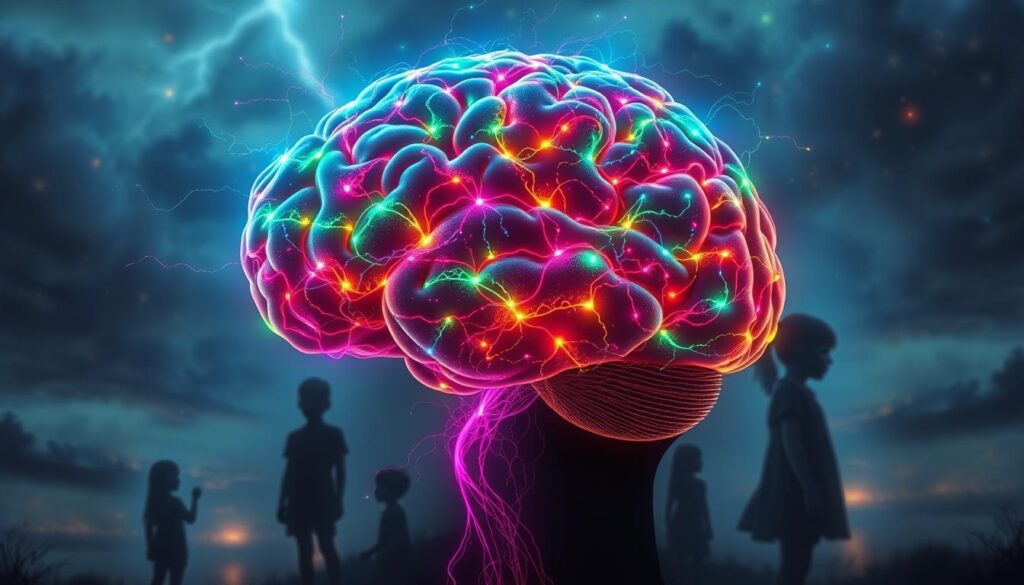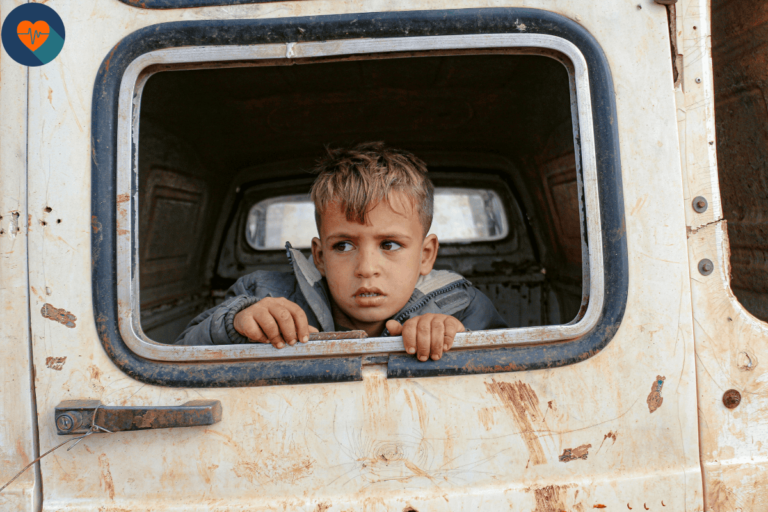Table of Contents
Childhood trauma can leave deep scars. It influences the way we perceive the world, experience emotions, and behave. But, healing and finding peace is possible if you face your past and tap into your inner strength.Overcoming Childhood Trauma
Trauma, in all its forms, can deeply affect us. It can stem from abuse, neglect, or the loss of someone important. These experiences can make us feel hurt, untrusting, and unsure of our value. Remember, your past doesn’t define you. You have the strength to rise above it.f

Starting this journey, know you’re not alone. Many have overcome their pasts and built new futures. With the right support and perseverance, you can do it as well. You can find the resilience needed to move forward.
Understanding the Nature of Childhood Trauma
Childhood is a time of growth but also vulnerability. Traumatic events, like abuse or neglect, can deeply affect a child’s emotional development. It’s important to understand these effects to move past them.
Types of Childhood Trauma and Their Impact
Childhood trauma comes in many forms, each with its own effects. Abuse, neglect, and violence can change a child’s sense of safety. Survivors may struggle with childhood wounds, such as fear of rejection or trouble forming relationships.
Recognizing Signs of Past Trauma
Seeing the signs of traumatic experiences is the first step to healing. These signs include fear of abandonment or trouble trusting others. Survivors may also develop survival mechanisms and emotional reactions that can harm them as adults.
Common Triggers and Responses
Some situations can trigger memories of past traumas, causing strong emotional reactions. These reactions, like fight or flight, show how the child tried to cope. Knowing these patterns helps in finding better ways to deal with emotions.

The Science Behind Trauma’s Long-term Effects
Childhood trauma leaves deep emotional scars. But it also affects our biology and behavior. From the womb to adulthood, trauma can have lasting effects.
Stress or trauma in a mother can harm an unborn child. It can lead to high cortisol levels. This can cause a hyperactive fight-or-flight response in the child later on.
- Research shows clear differences in nine brain regions between those who experienced childhood trauma and those who did not.
- Emotional abuse and neglect can lead to decreased size in brain areas like the corpus callosum, hippocampus, prefrontal cortex, and cerebellum.
- Childhood maltreatment has been linked to increased risks of anxiety, depression, PTSD, and other mental health conditions.
These effects can pass down through generations. Unresolved trauma can make it hard to manage emotions and form relationships. It can also affect physical health. Knowing how trauma works is key to healing.

How Childhood Experiences Shape Adult Behavior
Your childhood can deeply affect your adult life. Trauma, neglect, or tough family situations can harm your self-worth and trust. They also shape how you cope with problems.
Impact on Relationships and Trust
Adults who experienced childhood trauma may struggle with trusting others.. They might fear being left or betrayed. This can make them pull away from people and ruin relationships.
Effects on Self-worth and Identity
Childhood experiences can also affect how you see yourself. Abuse, neglect, or constant criticism can lower your self-esteem. This might make you try too hard to please others or struggle to find your true self.
Behavioral Patterns and Coping Mechanisms
To deal with past pain, you might turn to unhealthy habits. This could include drugs, dangerous activities, or staying distant from others. These coping methods might offer temporary relief but can keep you stuck in negative patterns.
Recognizing how your childhood affects you now is key to change. By understanding your past and seeking help, you can build better relationships and a stronger sense of self. You can also find healthier ways to handle life’s challenges.
The Mind-Body Connection in Trauma Recovery
Trauma is more than just a mental issue. It deeply affects the body, including the nervous system and stress responses. Understanding how the mind and body are connected is key to healing from trauma. Practices that focus on the body can help overcome past traumas.
Mindfulness practices, such as deep breathing and body scans, assist in soothing the nervous system. They make us feel safer in our bodies. By being more aware of our bodies, we can handle physical signs of trauma better. This helps us feel less overwhelmed and more emotionally strong.
- Somatic experiences, like shaking or trembling, help the body deal with unresolved trauma.
- Practices that improve body awareness, such as rocking or balancing, help the brain and body work together better.
- Techniques like Emotional Freedom Technique (EFT) tapping can improve brain connections and reduce inflammation, helping in recovery.
It’s important to address both the mental and physical sides of trauma for lasting healing. By recognizing the mind-body connection, we can stop generational trauma and regain our sense of self-worth.
Overcoming Childhood Trauma: Steps to Healing
Healing from childhood trauma takes courage, patience, and kindness to yourself. The first step is to accept and acknowledge your past.Recognizing the long-term impact of trauma is essential for moving forward.
Acknowledging and Accepting Your Past
Childhood trauma deeply affects a person’s mental and emotional health. It’s important to grasp how your trauma has shaped you. This self-reflection is hard but crucial for healing.
Building a Support System
Having a supportive network is vital during your healing. This can include friends, family, or a trauma therapist. Sharing your story with others who get it can offer comfort and community.
Professional Treatment Options
Professional help is often essential for trauma recovery. Therapies like cognitive-behavioral therapy, EMDR, and trauma-focused therapies can be very helpful. A skilled therapist can support you every step of the way.
Overcoming childhood trauma is tough but worth it. Be patient, kind to yourself, and open to support. With time and effort, you can move past your past and start a fulfilling life.
Breaking the Cycle of Generational Trauma
Generational trauma is when traumatic experiences are passed down through generations. Scientists have studied the children of Holocaust survivors to learn about this. This trauma can be shared through parenting, emotional responses, and even changes in genes, leading to cycles of abuse.
People who carry this trauma may face anxiety, depression, or PTSD. It can mess with how they handle emotions, their relationships, and lead to unhealthy coping habits. It can also raise the risk of health problems like heart disease and diabetes.
To break this cycle, it’s important to be aware, heal personal wounds, and create a safe space for future generations. Knowing how trauma is passed down is key. By practicing trauma-informed parenting, being mindful, and managing emotions, parents can better meet their children’s needs.
Creating new family patterns and talking openly about past traumas helps break the cycle. Getting professional help and going to family therapy can also support this journey. Healing from generational trauma often requires help from mental health experts and support from communities.
It’s vital to start new behaviors, reconnect with cultural roots, and take care of oneself. Building a support network and pushing for trauma awareness are also important steps. These actions help in healing and stopping the cycle of trauma.
Developing Healthy Coping Strategies
Getting over childhood trauma is more than just facing the past. It’s about finding ways to deal with its lasting effects. These strategies help you handle stress, control your emotions, and build strength for a better future.
Mindfulness and Grounding Techniques
Mindfulness and grounding are great for stress management and emotional regulation. Mindfulness helps you stay in the moment and understand your feelings without judgment. Grounding exercises, like deep breathing, help you focus on the present and lessen the impact of traumatic memories.
Self-care Practices for Trauma Survivors
For trauma survivors, self-care is crucial. This includes staying active, getting enough sleep, eating well, and relaxing. Taking care of yourself boosts your resilience and aids in your healing.
Building Emotional Resilience
Building emotional resilience is key to coping with childhood trauma. It means having a positive view of yourself, being kind to yourself, and facing tough times with courage. By developing these inner strengths, you can move from just surviving to truly thriving.
Healing from childhood trauma is a journey, not a straight path. But by using these healthy coping strategies, you can take charge of your well-being and start living your life again.
Creating Boundaries and Healthy Relationships
Surviving childhood trauma means setting healthy boundaries is key. It helps you build meaningful relationships. Learning to communicate your needs and stand up for yourself is important. It also helps you spot and avoid bad relationship patterns.
Building trust takes time, but it’s worth it. Surrounding yourself with caring people helps your healing. This support is crucial for your growth.
Learning to form strong connections is vital. Therapy or support groups can teach you these skills. They give you the tools to create the relationships you want.
Healing from trauma is a journey that takes time and patience. Be kind to yourself and your partner. Creating a safe space for open talk is essential. It lets you share your feelings without fear of being judged.
FAQ
What is the prevalence of childhood trauma?
By the age of 16, more than two-thirds of children experience childhood trauma. Up to 43% experience sexual abuse, and 85% witness community violence.
What types of experiences can be considered childhood trauma?
Childhood trauma can result from physical or sexual abuse, emotional neglect, witnessing violence, loss of a loved one, or an unstable home environment.
How can childhood trauma impact individuals in adulthood?
Childhood trauma can shape how individuals view themselves and the world. It often leads to long-lasting effects in adulthood. This includes fear of rejection, difficulty forming relationships, struggles with self-worth, constant need for validation, and emotional outbursts.
What are common signs of past childhood trauma?
Signs of past trauma include fear of abandonment, difficulty trusting others, and avoiding conflict. Common triggers may involve situations reminiscent of past traumatic experiences. This leads to fight, flight, freeze, or fawn reactions.
How does childhood trauma affect the body and nervous system?
Trauma can have biological impacts. Babies absorb cortisol in the womb if the mother experiences stress or trauma during pregnancy. This predisposes them to heightened stress responses. Growing up in unsafe environments can lead to a hyperactive nervous system. This perpetuates intergenerational trauma.
What are the long-term effects of childhood trauma on adult behavior and relationships?
Childhood trauma can lead to difficulties in forming close relationships. It also causes struggles with self-worth and the development of maladaptive coping mechanisms. This includes depression, anxiety, isolation, substance abuse, or risky behaviors. Trust issues often persist, making it challenging to form healthy relationships.
How can the mind-body connection be addressed in trauma recovery?
Trauma is stored in the body, affecting the nervous system and stress responses. Practices like deep breathing, mindfulness, and body awareness can help regulate the nervous system. This allows for more comprehensive healing approaches.
What are the essential steps in the healing process for childhood trauma?
Healing begins with acknowledging past experiences and their impact. It involves building a support system of trusted individuals. Engaging in professional treatment options like cognitive-behavioral therapy, EMDR, and trauma-focused therapies is also important. Self-compassion and patience are key throughout the healing process.
How can individuals break the cycle of generational trauma?
Breaking generational trauma cycles involves awareness and healing personal wounds. Creating a safe environment for future generations is crucial. Understanding how trauma is passed down biologically and behaviorally is important. Practicing mindfulness and emotional regulation, and openly discussing past traumas can contribute to breaking the cycle.
What are effective coping strategies for trauma survivors?
Developing healthy coping strategies is essential. This includes mindfulness and grounding techniques, self-care practices, and building emotional resilience. These strategies support long-term healing and help trauma survivors move from survival mode to a state of thriving.
How can trauma survivors establish healthy boundaries and relationships?
Establishing healthy boundaries involves learning to communicate needs effectively. Practicing assertiveness and recognizing unhealthy relationship patterns is important. Building trust gradually and fostering meaningful connections can help overcome the relational challenges often associated with childhood trauma.

